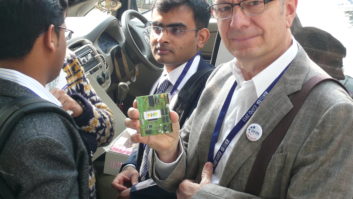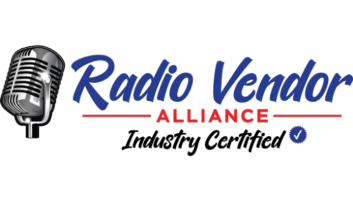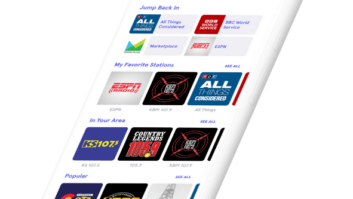Practical form, affordable plans
Dec 1, 2004 12:00 PM, By Chriss Scherer, editor
Before any facility project begins, an engineer must determine the equipment and facility needs and then apply the budgetary structure. This simple plan is rarely so simple because of the unique challenges of a particular facility. When Nassau set out to build a consolidated facility for its station in southern New Hampshire, the goal was to create a reliable and functional facility without breaking the bank.
Air control 5 is set up like the production studio layouts.
Studio Hub jack panels are placed at each mic position for a headphone jack and control.
The rack room houses nine equipment racks, plus two open-frame racks for the office networks and phone system.
Each air studio has its own rack. The multi-conductor cable tieline is terminated on the rear-rail-mounted panels.
The studio end of the multi-conductor tielines are mounted in the furniture.
The studio facility is in Hookset, NH, which is just north of Manchester. Nassau owns nine stations in New Hampshire, five of which are housed in Hookset. Nassau acquired the nine stations when it purchased them from Vox Radio and Telemedia.
At the end of October, two of the five stations were in place: WNNH and WHOB, which Nassau purchased from Telemedia. Three more stations will move in the coming weeks: WJYY, WNHI and WOTX, which were owned by Vox. The two Telemedia stations already occupied space in the Hookset facility, but additional work was needed to prepare for the three additional stations.
The other four Nassau stations have studio facilities in Guilford, NH.
Laying plans
The Hookset location was originally chosen by Telemedia, and Nassau chose to stay in this area because it is between the two cities served by the stations: Concord and Nashua. While Telemedia had nearly completed its installation for the two stations, Nassau immediately decided to rework what had been started. While the facility locations had several shortcomings, the existing investment in the space and a long-term lease confirmed the decision for Nassau to modify the facility to house the additional stations instead of relocating.
The first step was to rearrange several offices to accommodate the additional studios. In all there are now nine studios � five air studios and four production studios � for the five stations.
The studios were designed for each to use one of two common layouts for on-air or production use. Because of space limitations, the fifth air studio uses the production layout. The station that occupies this space does not carry a live format all day, so the reduced size is not a problem.
The air studios’ U-shaped furniture layouts are identical, although two studios are mirror images of the other two. The overall design goal of the reshaped facility was to provide function with a straight-forward equipment complement. In keeping with this plan, analog consoles with an audio router were coupled with a rapidly deployed wiring system.
Radio Systems Millennium consoles were chosen. These were tied to an SAS 64000 router. The Radio Systems Studio Hub+ serves as the wiring backbone.
While Nassau liked the features of the Millennium consoles, there was one shortcoming that had to be addressed. The original consoles had minimal telephone bus support. Dirk Nadon and Tony Gervasi of Nassau worked with Radio Systems to improve the bus system for simpler telephone feed support, such that an off-line mix can be used to take calls off the air, while a second mix can be fed to the phone when it is routed to be used on the air. This feature is available in higher-end consoles, but Nassau was impressed with the Millennium and wanted to use them in the facility. Now that the development is complete, Radio Systems now offers this capability as a standard option.
The Studio Hub system allowed fast equipment installation. By using connector panels and prefabricated CAT-5 cable assemblies, few connectors had to be soldered. The CAT-5 cables were bought in bulk, and multiple cable runs were terminated with punch assemblies. The Studio Hub system also eliminated the need to devote a large space for a punch block wall.
The facility itself had a few shortcomings that had to be addressed. First, there is no line-of-sight access to the stations’ transmitters sites for wireless STLs. T1 circuits are used to connect the studios to their facilities. In one case, T1 service is not available to a transmitter site, so the STL is double hopped via a T1 to another transmitter site and then carried by wireless STL to the final destination.
Some programs are received via the AMC-8 satellite. Because of the low site elevation and high tree cover, the satellite dish had to be placed on one end of the site property and then mounted on a 20-foot pole to clear the ground clutter.
The Hookset site connects to the Nassau corporate offices in Princeton, NJ, via three T1 lines. This interconnect provides WAN access as well as system redundancy for data backups.
In the rack room
Each air studio has its own rack for processing, STL, EAS encoder and air monitor tuner. The back of each air-studio rack has three Studio Hub panels. The production studios do not have their own racks, so their blocks are mounted on the back wall.
The other racks house the office network, office telephone system, the SAS 64000 audio router, monitoring equipment and Broadcast Electronics Audiovault servers. The Audiovault runs an NFS server and uses linear audio encoding.
The original studio installation had a 12-pair cable installed from the telephone company. Nassau added 100-pair service, which was a challenge that required coordination with the other tenants in the building.
Minor variations
While the air studios use Telos 1�6 telephone systems, the production studios did not need this level of flexibility. Instead, a Radio Systems DI-2000 phone hybrid is connected to the office telephone system through an analog extension port. This allows the phone to be used to play client spots and conduct other business functions that are more common than any on-air phone needs.
The facility construction project is not yet complete. As mentioned earlier, the final stations are moving in sometime this winter. In addition, the office area is being remodeled for the new staffs. This phase of the project includes building out an additional suite in the building for a news sales office area.
The Hookset installation is an example of a functional, modern facility that was completed within tight budget constraints. This approach has provided a facility with the necessary flexibility needed in a competitive market.
Equipment List
360 Systems Shortcut
Adobe Audition 1.5
APC 1000XM UPS
APC 2200XL UPS
Aphex Compellor 320A
Beta Brite LED signs
Broadcast Electronics Audio Vault
Comrex Matrix
Crown D-75A
Dayton Industrial AFC3
Denon DN-C635
Denon TU-1500RD tuners
Dorrough 1200B
Electro-voice RE-20
Enberg BA-12
Ergotron computer monitor supports
Eventide BD500
Gepco E131675 and GA61820GFC
Harris Intraplex STL HD
Harris World Feed panel
Henry Engineering Superrelay
JBL 4408
KRK ST6
LPB Silent Mic Booms
Middle Atlantic racks, shelves and drawers, power strips
Quintech antenna DA
Radio Systems CT-2002 clock
Radio Systems Millennium
Radio Systems Studio Hub +
Radio Systems DI-2000
RDL ST-U, ST-PDS, ST-UMX3, ST-GCA2
Sage Endec
SAS 64000
Sine Systems MBC-1
Sony MDS-E12
Studio Technology furniture
Symetrix 528E
Tascam 122 MkII
Telos 1�6
Whirlwind cable assemblies
The Nassau Crew
Dirk Nadon – director of engineering, New Hampshire stations
Ron Leroux – IT director
George Bierbaum – staff engineer
Steve Ordinetz – staff engineer











